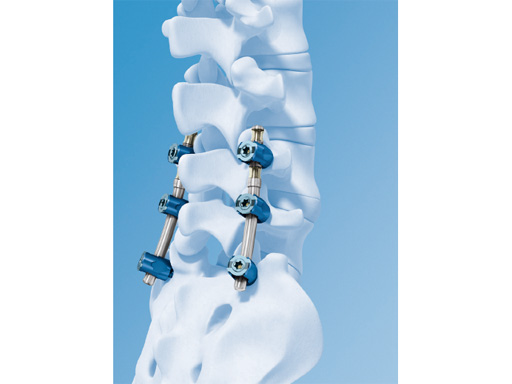
NFlex Stabilization System
The NFlex stabilization system is a semi-rigid rod for posterior lumbar stabilization. The rods are designed to be used with either the pangea or click'X pedicle screw systems.
NFlex enables dynamic stabilization of the posterior lumbar spine. Principles of dynamic stabilization include decreased stiffness compared to traditional rigid stabilization and increased load sharing with surrounding anatomical structures. Dynamic constructs provide less resistance to spinal loading and motion. The NFlex rod motion allows more load transmission to the anterior column than rigid fusion.
The main goal of the NFlex surgical technique is to implant the rod so that the patient can utilize the full range of motion and load-sharing capabilities of the device.
Fig 1 NFlex construct.
The NFlex stabilization system features precurved and straight rods for mono- and multisegmental posterior stabilization. The rods feature dynamic and solid ends for transitional rigidity. A titanium ring allows for sliding and toggling coupled motion. The polymer sleeve bumper allows for controlled titanium ring motion in flexion, extension, lateral bending, and axial rotation at the dynamic level. Finally, a titanium alloy tapered core provides transitional rigidity.
Lengths of the NFlex rods are 4085 mm in 5 mm increments. The set also includes a 150 mm straight rod. Four trial implants are provided, corresponding to the various rod lengths from 4085 mm. In addition, a 150 mm long bending template is included in the set to establish the contour of the 150 mm straight NFlex rod.
Fig 2ac The NFlex rod motion allows more load transmission to the anterior column than rigid fusion.
Hazards and labeling
Due to varying countries’ legal and regulatory approval requirements, consult the appropriate local product labeling for approved intended use of the products described on this website. All devices on this website are approved by the AO Technical Commission. For logistical reasons, these devices may not be available in all countries worldwide at the date of publication.
Legal restrictions
This work was produced by AO Foundation, Switzerland. All rights reserved by AO Foundation. This publication, including all parts thereof, is legally protected by copyright.
Any use, exploitation or commercialization outside the narrow limits set forth by copyright legislation and the restrictions on use laid out below, without the publisher‘s consent, is illegal and liable to prosecution. This applies in particular to photostat reproduction, copying, scanning or duplication of any kind, translation, preparation of microfilms, electronic data processing, and storage such as making this publication available on Intranet or Internet.
Some of the products, names, instruments, treatments, logos, designs, etc referred to in this publication are also protected by patents, trademarks or by other intellectual property protection laws (eg, “AO” and the AO logo are subject to trademark applications/registrations) even though specific reference to this fact is not always made in the text. Therefore, the appearance of a name, instrument, etc without designation as proprietary is not to be construed as a representation by the publisher that it is in the public domain.
Restrictions on use: The rightful owner of an authorized copy of this work may use it for educational and research purposes only. Single images or illustrations may be copied for research or educational purposes only. The images or illustrations may not be altered in any way and need to carry the following statement of origin “Copyright by AO Foundation, Switzerland”.
Check www.aofoundation.org/disclaimer for more information.
If you have any comments or questions on the articles or the new devices, please do not hesitate to contact us.
“approved by AO Technical Commission” and “approved by AO”
The brands and labels “approved by AO Technical Commission” and “approved by AO”, particularly "AO" and the AO logo, are AO Foundation's intellectual property and subject to trademark applications and registrations, respectively. The use of these brands and labels is regulated by licensing agreements between AO Foundation and the producers of innovation products obliged to use such labels to declare the products as AO Technical Commission or AO Foundation approved solutions. Any unauthorized or inadequate use of these trademarks may be subject to legal action.
AO ITC Innovations Magazine
Find all issues of the AO ITC Innovations Magazine for download here.
Innovation Awards
Recognizing outstanding achievements in development and fostering excellence in surgical innovation.






